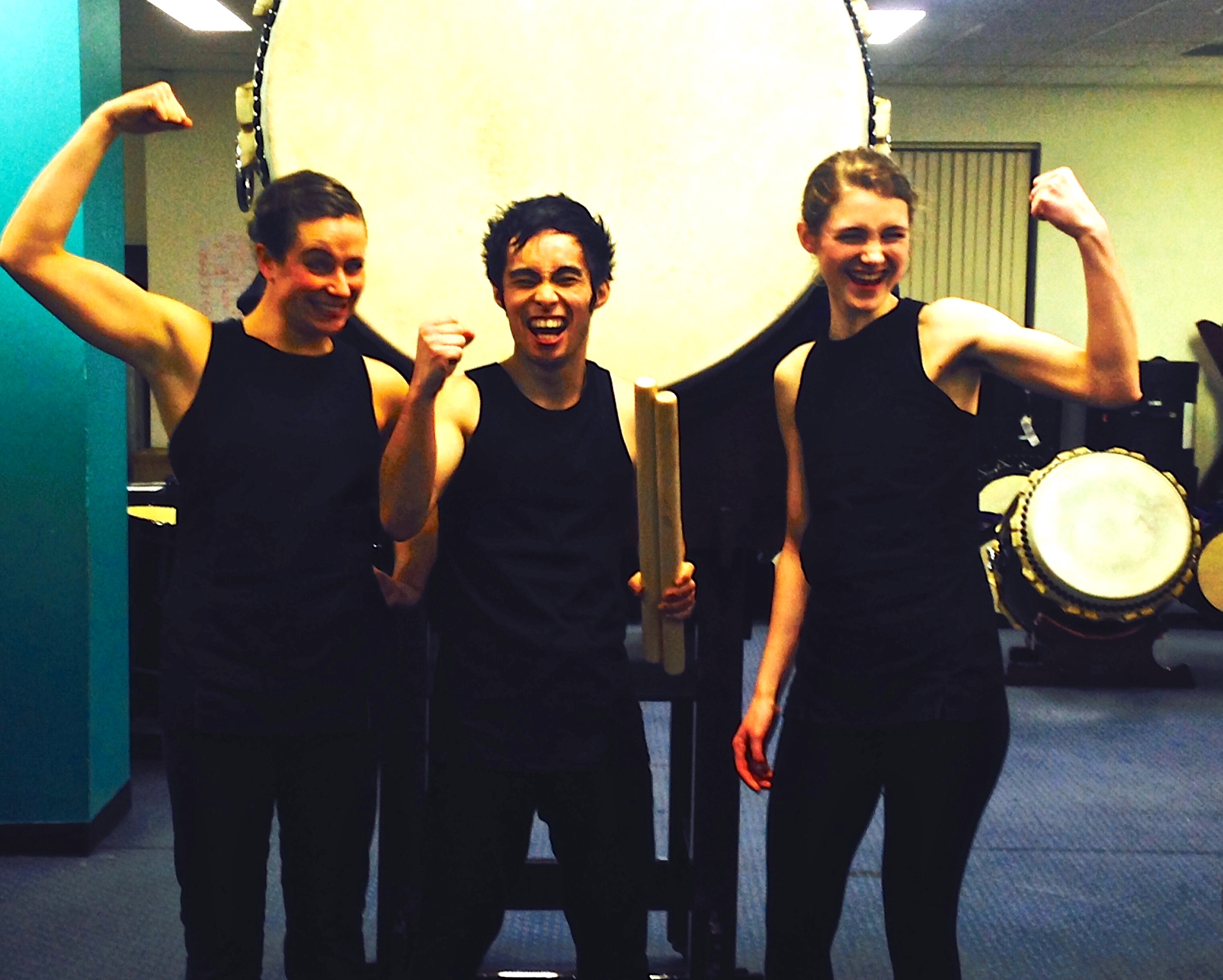IDP 2015: Sophie Unsen, Ryuji Hamada, Claudia Wherry
Over the last year I've been studying for a Bachelor of Music at UNSW. Taiko is my instrument and at the end of every semester we have a practical performance exam as part of our Performance Lab class. I've mostly been working on pieces for small taiko (shimedaiko and katsugi okedo), as well as various narimono (chappa, atarigane). My repertoire for this semester includes Yataibayashi (not to be confused with Chichibu’s Yataibayashi) from the suite of pieces known as O-Edo Bayashi, a study for atarigane based on O-Edo Bayashi, a solo arrangement of Monochrome by Maki Ishii, and two pieces that my teacher Kevin Man composed specifically for my Uni assessments. One of Kevin's pieces is for taiko set, and another for katsugi okedo, called 40.4. The katsugi piece was especially difficult to learn as each of the phrases in the first half of the piece has 40.4 beats (hence the title) due to some particularly challenging time signatures. However, the main challenges for this semester were Monochrome and Yataibayashi.
Because Monochrome is originally written for 7 players, we've been working throughout this semester on creating a solo study arrangement that still incorporates all the elements of the original work, but in a different order so it works musically as a solo piece. The other challenge with Monochrome is its technical difficulty as everything is very exposed and needs to be incredibly precise.
Learning O-Edo Bayashi over the last few months has been fascinating, as not only is the music itself complex and beautiful, but the style has it's own form of notation, which is read from top to bottom, right to left and uses katakana. Though it’s been hard, I'm gradually becoming more comfortable and fluent at reading the notation. Putting all the parts together with the ensemble musicians was a lot harder than I'd anticipated – it was starkly different to playing my part in isolation – but in the end we got it. For my performance on Wednesday November 11 of Yataibayashi, I'm going to be accompanied by Sophie Unsen playing shinobue, Tom Royce-Hampton odaiko (1.2 nagado) and Sophia Ang atarigane. [Claudia Wherry]
Subscribe
Click to Subscribe
Keep up to date with all Taikoz news by subscribing to our newsletter
What's On
IDP 2015: Sophie Unsen, Ryuji Hamada, Claudia Wherry
Over the last year I've been studying for a Bachelor of Music at UNSW. Taiko is my instrument and at the end of every semester we have a practical performance exam as part of our Performance Lab class. I've mostly been working on pieces for small taiko (shimedaiko and katsugi okedo), as well as various narimono (chappa, atarigane). My repertoire for this semester includes Yataibayashi (not to be confused with Chichibu’s Yataibayashi) from the suite of pieces known as O-Edo Bayashi, a study for atarigane based on O-Edo Bayashi, a solo arrangement of Monochrome by Maki Ishii, and two pieces that my teacher Kevin Man composed specifically for my Uni assessments. One of Kevin's pieces is for taiko set, and another for katsugi okedo, called 40.4. The katsugi piece was especially difficult to learn as each of the phrases in the first half of the piece has 40.4 beats (hence the title) due to some particularly challenging time signatures. However, the main challenges for this semester were Monochrome and Yataibayashi.
Because Monochrome is originally written for 7 players, we've been working throughout this semester on creating a solo study arrangement that still incorporates all the elements of the original work, but in a different order so it works musically as a solo piece. The other challenge with Monochrome is its technical difficulty as everything is very exposed and needs to be incredibly precise.
Learning O-Edo Bayashi over the last few months has been fascinating, as not only is the music itself complex and beautiful, but the style has it's own form of notation, which is read from top to bottom, right to left and uses katakana. Though it’s been hard, I'm gradually becoming more comfortable and fluent at reading the notation. Putting all the parts together with the ensemble musicians was a lot harder than I'd anticipated – it was starkly different to playing my part in isolation – but in the end we got it. For my performance on Wednesday November 11 of Yataibayashi, I'm going to be accompanied by Sophie Unsen playing shinobue, Tom Royce-Hampton odaiko (1.2 nagado) and Sophia Ang atarigane. [Claudia Wherry]

